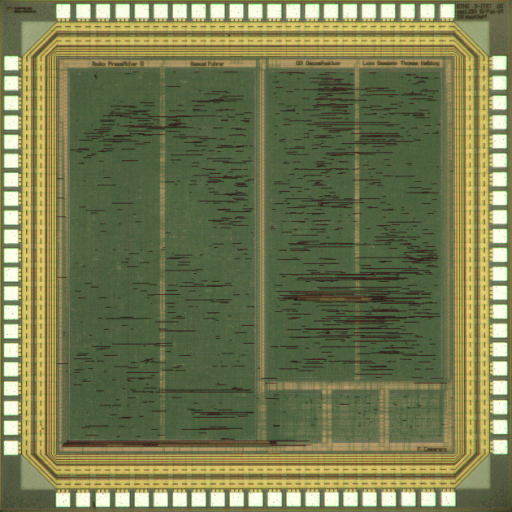The IIS Chip Gallery
QR_preamp (2004)

by

| Application | Communication |
| Technology | 250 |
| Manufacturer | UMC |
| Type | Semester Thesis |
| Package | LCC84 |
| Dimensions | 2500μm x 2500μm |
| Gates | 100 kGE |
| Voltage | 2.5 V |
| Power | 33.75 mW, 25MHz, 2,5V (Preamp) |
| Clock | 233 MHz (QR) 25MHZ (Preamp) MHz |
This chip contains two separate designs that were combined to save costs. The chips do not share any circuits and a small multiplexing circut at the bottom is used to share inputs and outputs. Complex Matrix QR Decomposition
For modern wireless communication systems the signal processing algorithms become more and more demanding. Algorithms related to Multiple-Input Multiple-Output (MIMO) systems employ the theory of linear algebra extensively.
A prominent and complex operation is the matrix inversion of a complex-valued matrix. Several approaches to realize this operation exist. A salient example is to first decompose the matrix into a orthonormal Q and triangular R part. Through back-substitution the inverse can be found easily.
In this project, the QR decomposition algorithm is implemented. To execute the oprations needed on the matrix, the processing element is implemented as a complex CORDIC (COrdinate Rotation DIgital Computer).
The QR processor uses iterative CORDICs since the processing elements need to run both in vectoring as well as in rotation mode.
The final QR processor calculates the R matrix of a 4x4 complex-valued matrix in 11.59 cycles. The chip was manufactured in 5-metal-layer CMOS technology at UMC. 1.2 mm2 is the size of the core area. The tested chip runs at 250 MHz.
Multi-Channel Digital Audio PreamplifierThe functionality of a digital preamplifier ranges from a simple stereo volume control to a multi-channel audio system with many features. From the beginning, it was the goal to create a chip that can handle 5.1 surround sound. The look and feel of the complete system should be the one of a classical analog amplifier with many analog items. The desire for multi-channel sound lead to the decision to implement a matrix decoder that can derive surround, center, and bass channels from a two channel stereo input signal. The chip is as well able to process true six-channel audio through a surround input. Additional features include a bass and treble filter and a programmable delay of the surround channels. To imitate the user interface of old-fashioned amplifiers, knob encoders are supported as control inputs. Multiple audio source inputs enable the chip to act as a central unit that can handle a great range of audio devices like CD player, tuner, mini-disc and DVD player.